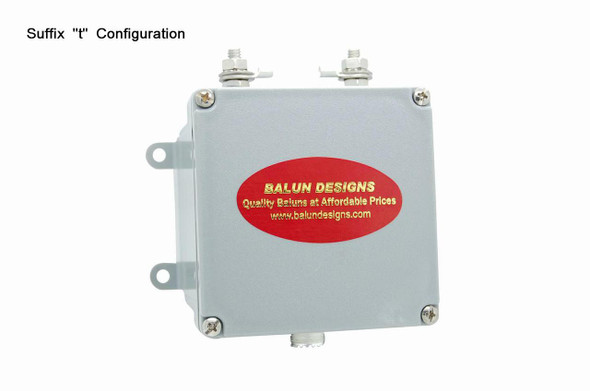Description
After numerous requests, Balun Designs is pleased to offer a specialized 1:1 balun optimized for 6 meters. The material for this core is optimized for 50-54 MHz and provides exceptional choking impedance at these frequencies. An isolation/choking impedance in excess of 3500 ohms is developed at 54 MHz. Note the core used for this balun is intended for primary use on the 6m band and will not provide high level choking or isolation at lower frequencies.
N connectors and mounting options are available in "Accessories & Connectors" section of our website
Testing shows SWR remains below 1.05 across the entire 6m band, transformation is perfectly flat, return loss is between 61-80 dbmw and choking impedance is maximized at over 3.5k ohms on the 6m frequencies.
Noise Reduction
While the most common advice is to improve the station's RF ground, the root of the problem is in the poor isolation of the feedline from antenna currents. If your goal is to reduce feedline radiation and improve reception by reducing noise, feedline isolation baluns are an excellent choice. Adding an additonal isolation balun at the point where the feedline exits the near field area of the antenna will substantially reduce unwanted feedline radiation and reception of EMI without the need for improved station grounding.
Specifications
| Core Material | Custom mix ferrite by Fair Rite Products optimized for 50 MHz. Large 2.4 inch cores |
| Winding Type | Single core, coaxial wound 1:1 current balun provides large effective core area. |
| Winding Material | Mil Spec 50 ohm coax rated 19kW @ 1MHz Silver flashed braid and center conductor with solid Teflon dielectric. |
| Power Rating | 54MHz, 3kW All ratings at resonance. High SWR will reduce power handling ability. |
| Useable Frequency | 35-60 MHz |
| Insertion Loss | Less than 0.1db |
| Connectors | SO-239 connectors are gold center conductor with Teflon insulation. Studs and eyebolts are 1/4 inch. Alternate connectors and Mounting Options are available in the Accessories section. |
| Hardware | All Stainless Steel |
| Enclosure Type |
NEMA rated 4x marine grade junction box for outdoor installations. Cover utilizes integral neoprene gasket for weatherproof integrity. |
| Dimensions | 4x4x2 inches for main body of unit Dimensional Drawing of Standard Enclosure |
| Additional Info | Very high efficiency. Will not heat up or saturate like many of the "less expensive" designs. |
Warranty Information
Noise Reduction
It is a seldom appreciated fact that feedlines which are not adequately decoupled can act as efficient vertical antennas that degrade an otherwise excellent radiation pattern. The addition of a quality feedline isolation ("choke") balun can significantly reduce feedline radiation and dramatically decrease RFI and TVI. It does this by providing the antenna with balanced current at the feedpoint and by effectively preventing the coax shield from acting as part of the antenna.
While the most common advice is to improve the station's RF ground, the root of the problem is in the poor isolation of the feedline from antenna currents. If your goal is to reduce feedline radiation and improve reception by reducing noise, feedline isolation baluns are an excellent choice. Adding an additonal isolation balun at the point where the feedline exits the near field area of the antenna will substantially reduce unwanted feedline radiation and reception of EMI without the need for improved station grounding.
If your antenna SWR is already low and you wish to reduce feedline radiation and improve reception, a feedline isolation balun is recommended. Adding one at the base of a vertical antenna will substantially reduce unwanted feedline radiation (RFI) by preventing your antenna from using the your coax feedline as a radial. This can also reduce the need for improved station grounding.
Benefits to Vertical Antennas
When quarter-wave antennas are constructed over a near perfect radial system, they have a feedpoint impedance of about 36 ohms. When they are constructed over a less than optimal radial-system there is a loss introduced into the feed system that adds to the 36-ohm figure. This improves the SWR but there is a loss in the efficiency of the antenna, signals transmitted and received have a higher take-off angle and often there is current introduced onto the feedline.
With my SteppIR vertical I use two of these baluns. One at the base of the antenna and another midway along the feedline after the near field of the antenna. You can also install the balun where it enters your shack if you would rather not break the feedline run. The balun balances the RF currents at the antenna, is terrific for keeping RF out of your operating environment and greatly reduces the noise inherent in a vertical by decoupling the feedline.
With a ground-mounted quarter-wave vertical, regardless of the radial situation, but especially with poor radial systems, there is the need for a feedline isolation balun to keep common mode currents off the feedline.
Benefits to Yagis
Yagi antennas especially, benefit from improved balanced drive and superior feedline isolation, but even simple dipoles benefit from properly selected and installed Feedline Isolation baluns. In addition, receiver noise may also be reduced by eliminating stray EMI picked up by the coax shield.
Another very useful application for a feedline isolator is installing them in series with a yagi antenna’s normal feed system. The proper location is between the antenna’s matching device/system and the feedline. Doing this will not affect the antenna and prevents the feedline from acting as part of the antenna. In beam installations, using a feedline isolator in series with the antenna’s feed system can substantially improve the antenna’s front-to-back and front-to-side ratios.















